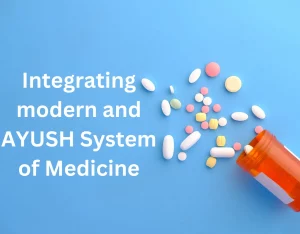ForumIAS announcing GS Foundation Program for UPSC CSE 2025-26 from 19 April. Click Here for more information.
ForumIAS Answer Writing Focus Group (AWFG) for Mains 2024 commencing from 24th June 2024. The Entrance Test for the program will be held on 28th April 2024 at 9 AM. To know more about the program visit: https://forumias.com/blog/awfg2024
Source: The post integrating modern and traditional medicine (AYUSH) systems has been created, based on the article “How AYUSH and modern medicine can work together” published in “Indian express” on 11th March 2024.
UPSC Syllabus Topic: GS Paper 2-governance- Issues relating to development and management of Social Sector/Services relating to Health, Education.
News: The article discusses the challenges and possibilities of integrating modern and traditional medicine (AYUSH) systems. Integrating modern and AYUSH System of Medicine
What are the models for integrating modern and traditional medicine (AYUSH) systems?
Competitive Model: Features rivalry between modern and AYUSH medicine, with each pointing out the other’s weaknesses and competing for patients. This model involves conflicts at the level of professional associations and possible litigation.
Coexistence Model: Recognizes both systems’ legitimacy, allowing them to operate separately without interference. In this model, modern medicine practitioners may permit patients to opt for AYUSH treatments. Conversely, AYUSH practitioners typically request patients to discontinue their modern medications if they wish to start AYUSH therapies.
Cooperation Model: Ideal integration where both systems acknowledge each other’s strengths and work together for patient care. This could improve modern medicine’s focus on prevention. For example, yoga is increasingly accepted by modern practitioners due to evidence of its effectiveness.
What are the challenges in integrating modern and traditional medicine (AYUSH) systems?
Trust Deficit: There’s skepticism between practitioners of modern and AYUSH systems due to varying outcomes when patients switch treatments, often based on anecdotal evidence.
Technical Differences: AYUSH is diverse, with each discipline requiring unique integration strategies. For example, yoga’s effectiveness is recognized, but integrating ayurvedic or homeopathic medicines remains contentious.
Operational Challenges: Effective teamwork requires understanding each other’s strengths and limitations. However, there is a lack of knowledge about AYUSH among modern medicine practitioners and vice versa.
Regulatory Issues: The regulation of integrated practices is evident, as modern practitioners sometimes use ayurvedic pills without full understanding. Similarly, AYUSH practitioners may practice modern medicine without proper authorization.
What should be done?
Build Evidence for AYUSH: Enhance trust by developing evidence-based AYUSH treatments, filtering out ineffective ones.
Create Composite Guidelines: If evidence supports, develop combined standard treatment guidelines integrating the best of both systems.
Implement Strong Regulation: Establish clear rules for collaboration, with accountability defined for both AYUSH and modern medicine practitioners.
Educational Integration: Consider teaching basic AYUSH concepts in modern medical courses, but without overburdening the curriculum.
Health Technology Framework: Utilize existing frameworks in India for assessing and regulating integrated practices, focusing on safety, quality, and efficacy.
Question for practice:
Examine the strategies and challenges involved in integrating modern and traditional medicine (AYUSH) systems.





